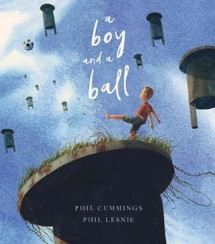A boy and a ball by Phil Cummings

Illus. by Phil Lesnie. Scholastic, 2020. ISBN: 9781743812525.
(Age: 4+) Highly recommended. A boy playing soccer with his brother
against the background of a war ravaged city will evoke scenes seen
nightly on television as children cope with the war that surrounds
them. Readers will wonder at the black mechanical figure slumped
against the crumbling buildings.
The boy is called by his brother; he must leave the ball and come
with him to his father. The trio shelters in their house as war
rages overhead, the black figures now like bombs falling from the
sky, until father decides they must leave. He has heard of a place
where the grass is green and soft underfoot, a place where there is
nothing to fear.
Anxiously they leave their home walking to a creaking boat and board
it to cross the ocean. Even here they are aware of the danger as
black figures rise from the deep, shadowing their terrible journey.
But the place they find is fenced and gated, the black figure now a
sentry post outside the wire watching them. The boy plays soccer but
one day the ball rolls under the fence and stops outside his reach.
What happens next will evoke questions, predictions, understandings,
sympathies.
This arresting story, underlining the compassion we feel when people
are badly dealt with, Cummings' last line, designed to ring a
response from the coldest of hearts, will promote discussion amongst
its readers.
Children know that there are families held in detention risking all
to get to Australia, and Cummings' story brings the tale of many to
the simplicity of a boy and a ball, encouraging readers to focus
their attention on the crux of the matter.
Supporting the story are the remarkable illustrations by Lesnie,
whose watercolour images create the dreadful images of war; the
looming black figures, the crumbling walls, night sky filled with
light from rockets and tracers, barbed wire fencing, bare dismal
huts for the detained. Readers will offer different ideas behind the
black figures: more literal ones like bombs, tanks, or sentry boxes
while others may see authoritarianism, bureaucracy, an ominous and
brooding fear. Lesnie says he first saw them as robots, but then
refined them to be sentinels, a 'clear visual shorthand for the kind
of systems that keep us cruel and complicit.'
Both author and illustrator provoke the reader to question their own
stance, to apply compassion to those relegated to inhumane treatment
by a government which says it is acting on our behalf. And all this
through the seemingly simple tale of a boy and a ball.
Themes: Refugees, Soccer, Detention centres, Compassion, War, Asylum
seekers.
Fran Knight